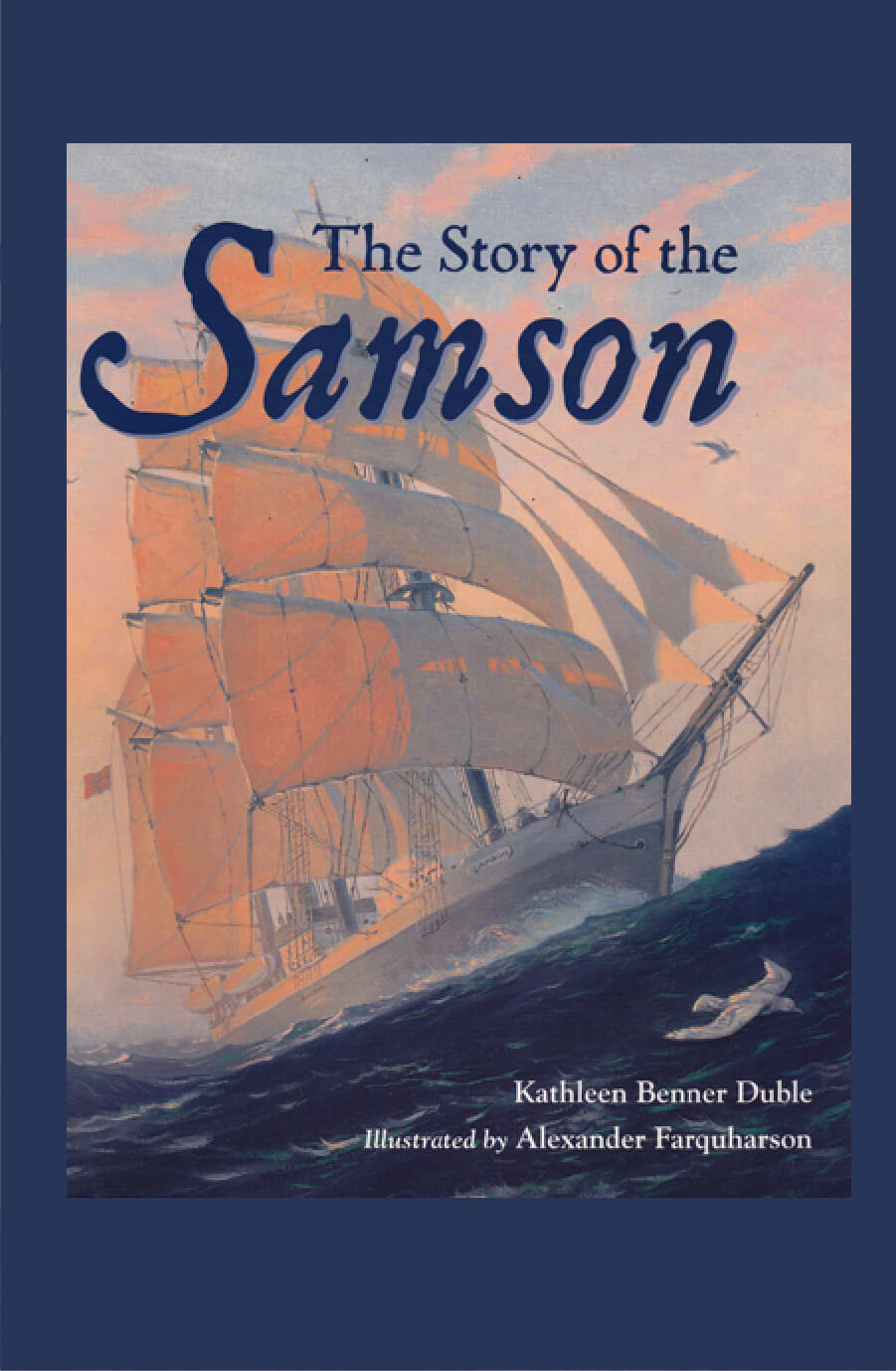

The Story of Samson
Publisher: Charlesbridge Publishing, June 2008,
Age group: 7-10
Jacket illustration: Alex Farquharson.
Genre: Historical Fiction
ISBN 13: 978-1580891844
To buy this book
- Description
- Book Club Ideas
- Discussions
Description
Climbing into his grandfather’s bed, Sam asks to be told the Story of the Samson, the tale of a whaling boat that toured the world. From exploring in Antarctica with Admiral Byrd to seeing the Titanic sink, this little boat has had a lifetime of exciting adventures. And Sam and his grandfather sail away with her as her story unfolds.
NCSS Notable Trade Book
“The Samson, a schooner built in 1885, was part of many major events in maritime history. First it was a sealing schooner, then a whaler, an exploration ship, and finally a trade ship. In its most noticeable roles, the Samson played a part in the rescue of Ernest Shackleton’s crewmates and Admiral Byrd’s Antarctica explorations, and it may have been the mystery boat that was seen by survivors of the Titanic. Duble presents the details of this ship’s history through conversations between a fictional young boy, Sam, and his grandfather, who was a crewman aboard the Samson. The narrative device creates a compelling introduction to maritime history, and the mix of full-color and sepia-toned oils enhances the historical subject. A time line, author’s note, and list of resources conclude this engrossing introduction to adventure at sea.” – BOOKLIST.
For more information on the Samson and other famous sailing vessels,
click here
Book Club ideas
Ideas for book clubs
FOR THE STORY OF THE SAMSON :
VENUE: Why not outfit your own home into a scrapbooking wonderland? Like Grandpa had done, have your book clubbers bring in a scrapbook and materials to create a memory map of their own lives. What would they put in it? What would be important to them?
FOOD: The Samson visited the Caribbean many times as it made its voyage to haul molasses back to Nova Scotia. So why not serve food from the islands? Here are some recipes you might like to try.
Caribbean Lime Chicken
Ingredients:
* 2-2 1/2 lbs chicken pieces (breasts, thighs and drumsticks)
* 1/2 teaspoon lime zest
* 1/4 cup lime juice
* 1 tablespoon vegetable oil
* 3 garlic cloves, minced
* 1 teaspoon fresh ground black pepper
* 1 teaspoon basil, crushed
* 1/2 teaspoon kosher salt
Procedure:
- Heat oven to 450°F.
- Rinse chicken pieces and pat dry.
- Place chicken pieces on broiler pan.
- Broil 4-5 inches from heat for approximately 20 minutes.
- Meanwhile, stir remaining ingredients together.
- Brush chicken with mixture on both sides.
- Broil for another 5 – 15 minutes, until no longer pink.
- Brush with mixture often during last 5 minutes of cooking.
- Note: Watch carefully after brushing mixture on chicken!
Simple Caribbean Jerk Chicken
Ingredients:
* 1 envelope Italian salad dressing mix
* 2 tablespoons brown sugar
* 2 tablespoons oil
* 2 tablespoons soy sauce
* 1 teaspoon cinnamon
* 1 teaspoon thyme
* 1/2 teaspoon ground red pepper
* 2 1/2 lbs chicken pieces
Procedure:
- Mix all ingredients except chicken in bowl.
- Pour over chicken.
- Cover and marinate 1 hour or over night in fridge.
- GRILL it!
- Enjoy!
Caribbean Onion Rings with Spicy Dipping Sauce
Ingredients:
* 1 large sweet onion
* 3/4 cup flour
* 1/4 cup cornmeal
* 1 teaspoon lime zest
* 1/2 teaspoon baking powder
* 1/4 teaspoon baking soda
* 1/2 teaspoon salt
* 1/2 teaspoon cayenne pepper
* 1 large egg, lightly beaten
* 1 cup buttermilk
* oil (for frying)
Lime Dipping Sauce
Ingredients:
* 2/3 cup low-fat mayonnaise
* 2 tablespoons brown sugar
* 2 tablespoons honey
* 2 tablespoons lime juice
* 1 teaspoon horseradish
Procedure:
- Peel onion and cut into 1/4-inch slices, separating rings.
- In a medium-size bowl, combine flour, cornmeal, lime zest, baking powder, baking soda, salt and cayenne pepper.
- In a large bowl, combine the egg and buttermilk and stir. Add the flour mixture, and whisk until blended.
- Heat oil over medium-high heat in a heavy fry pan until temperature reaches 375°F.
- Dip onion rings into batter and carefully put into hot oil. Fry until golden brown, about 2 minutes, turning after one minute. Remove with fork and place on paper towels to absorb oil. Serve with Lime Dipping Sauce.
- Lime Dipping Sauce: Blend ingredients well. Make at least 30 minutes before serving.
Coconut Flan
Flan is a favorite treat throughout the islands and there are many versions. Here is a simple recipe for coconut flan.
Prep Time: 00:20
Cook Time: 01:00
Ingredients:
* 1 cup sugar (divided into 1/2 cup portions)
* 2 tablespoons water
* 5 eggs
* 1 14-oz can coconut milk
* 1 cup milk
* shredded coconut or pineapple chunks for garnish
Procedure:
- Heat oven to 350 Fahrenheit and get the baking pans ready. You will need an 8-inch square baking pan and a large roasting pan.
- Put 1/2 cup of sugar and the water in a small saucepan over medium-high heat. Bring to a boil, swirling pan until sugar melts. Boil for approximately 3 minutes or until syrup turns an amber color.
- Immediately pour into square baking pan. Tilt the pan to coat the bottom completely. It is all right if the syrup hardens.
- In a large bowl, beat eggs and coconut milk until well blended.
- Beat in remaining sugar and the milk then pour the mix into baking pan.
- Place the square baking pan inside the roasting pan.
- Add hot water to roasting pan until it comes halfway up the sides of smaller pan.
- Bake 55 minutes to 1 hour until a knife inserted near center comes out clean.
- Remove the square pan from the water and let cool completely.
- Cover and refrigerate at least 4 hours before serving.
- When ready to serve, run a knife around the edges of custard.
- Place an inverted rimmed serving plate over pan. Holding plate and pan together, carefully turn both over.
- Lift the pan and let they syrup run onto plate.
- Garnish with coconut and/or pineapple.
ONLINE RESOURCE: http://www.scrapbookscrapbook.com/beginners.html
SPECIAL GUESTS: There are many modern day explorers out there today. One of them is Benedict Allen. Here is his website: https://www.benedictallen.com/ He answers a lot of cool questions about being an explorer today. He also makes public appearances. Why not invite one of these modern day explorers and see if they would be willing to skype with your book club for 10-15 minutes in a question and answer format? Make sure to have great questions ready for them.
Discussions
The Social Studies Connection
The Samson touched Grandpa and Sam’s life in a deeply personal way, and while the boat is inanimate, it serves as a symbol of the human experience. Every day, we have a chance to affect someone in our lives. We can do this in a positive way with a smile, or negatively by criticizing others. THE STORY OF THE SAMSON presents the opportunity to talk to students about the way their lives move from person to person, leaving an impression behind and sometimes, changing lives.
Hands-On Activity: Begin with a discussion of people who have affected the world in great ways. Examples are: Mother Theresa, Ghandi, and Nelson Mandela. Have students create a chart, listing people whose lives they connect with daily. Have them reflect on the way they have affected that person, both positively and negatively. Encourage them to think of ways in which they could alter the effect they have on others so that the influence they have on them could change that person’s day or life.
The History Connection
The Samson was a part of an amazing number of historical events. It explored with Admiral Byrd, rescued two of Shackelton’s crewmembers, and was an exhibit at the 1933 Chicago World’s Fair. But history is not something that had to have happened decades or centuries ago. It is not something that happens only to people long dead and forgotten, but is a tangible part of the fabric of all of our lives. Many of us don’t realize that history is, simply put, yesterday, and that, like the Samson, we are all a part of it!
Hands-On Activity: Have students list several events they have already lived through. Encourage them to not only think nationally, but globally and locally. Discuss how these events have changed the world, their country or even the small town in which the students live.
The Science Connection
Technology is constantly evolving and changing, especially in the area of exploration. The computer on the first spaceship had the equivalent capacity of calculators today! Imagine going off to space with just your calculator! When Sam’s grandfather made his first voyage with the Samson, the instrumentation he would have used to navigate would have differed greatly from what seafaring explorer’s have at their fingertips now.
Hands-On Activity: Compare the scientific instruments of yesterday to today’s newer technology. Using the list below, have students research what today’s explorers use instead of these older navigational tools or how these same ones have improved over time.
| Sextant Celestial Navigation Compass |
Plumb Lines Chronometer Astrolabe |
Quadrant Sandglass Dead Reckoning |
The Art Connection
Man has always had a yearning to discover the “undiscovered.” But with the advent of the Internet and jet travel, our world has grown smaller, and the possibility to be a “true” explorer has diminished. Yet there are a few places still left relatively untouched by mankind: the very depths of our oceans and outer space.
Hands-On Activity: Have students draw what these uncharted areas might look like. What strange creatures might they encounter? What dangers might be lurking around the corner? What tools would they take with them to ensure their safety as they went on these dangerous undertakings? Can they imagine a world few people have ever witnessed? How do they envision it?
The Language Connection
True explorers cannot anticipate what they might discover or what they might actually need on their journeys. Unexpected dangers, unseen hazards, unforeseen circumstances can all alter the good intentions the explorer had at the beginning of the expedition. Imagination is as much a part of an explorer’s world as it is of a writer’s world!
Hands-On Activity: Give the students the following first line. “He stepped off into that unknown world and knew that he would never be the same.” Now it is the students’ turn. Using this line and the best of their imaginations, have each student write a short story about this explorer. They can place the story either in the past or the present or future. They are limited only as far as their imaginations wish to explore!


